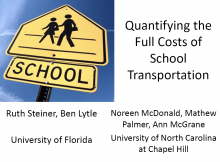We are pleased to announce an exciting new alliance between Active Living Research and GP RED to co-host and coordinate...
Quantifying the Full Costs of School Transportation

Presentation at the 2014 Active Living Research Annual Conference.
Background and Purpose
In the United States, $21.7 billion is spent annually on busing elementary and secondary students to and from school. This amounts to 4.2% of the total funds spent on public education in grades K-12 (U.S. Department of Education, 2011). Declining state and local revenues have made it imperative for school districts to manage transport costs, thereby preserving funding for classroom activities without sacrificing students ability to get to school. Students living within one mile of school are ten times more likely to walk or bike to school than those living more than a mile away (McDonald, et al. 2011). Yet school districts and municipalities regularly make decisions about where to site new schools and make investments in existing schools without fully understanding the impact of these decisions on overall transportation costs. Thus, the fact that current school location optimization algorithms only consider the cost of busing children to school is significant. This approach fails to recognize opportunities to locate schools in places that maximize active transportation potential and to consider tradeoffs between land values and transport costs.
The goal of this study is to document the full cost of getting children to school and develop a decision support tool to help transportation and school planners minimize transport costs when siting or improving schools. The multi-modal transportation costs are being rigorously studied at elementary schools in Florida and North Carolina. The variation in costs will be analyzed in relation to the school’s location type and its proximity to students. This will allow the researchers to develop a pilot decision support tool to estimate transportation costs of potential school sites.
This study will provide the first published evidence regarding the full cost of school transportation across all modes and including upfront and ongoing costs. This quantification will allow researchers and practitioners to consider how school site selection, investment in pedestrian and bicycle infrastructure near the school, and local residential development patterns impact costs. A better understanding of these costs will allow practitioners to economically justify siting decisions which consider the viability of active school transportation.
Description
The individual capital and operations cost items for each primary mode of transportation—automobile, school bus, bike, and walking—were identified to allow for the consistent collection of data between states and school districts. Eight public elementary schools were selected from Florida representing urban and suburban environments both in areas with high and low densities of student populations. The same criteria were used to select 12 schools in North Carolina, with the addition of four schools representing rural environments. School districts, published reports, and professionals associated with the design and planning of the study schools will be consulted to gather cost and other relevant information. A school site visit was conducted to determine the travel mode split at each study school. Based on these results, the researchers will develop a pilot decision support tool which will assist transportation and school planners in determining estimated transport costs by mode for proposed school locations.
Lessons Learned
Data collection is currently ongoing. Preliminary findings suggest that schools located in higher density areas have lower school transportation costs and higher active transportation mode shares. The pedestrian infrastructure around schools is another important factor in assessing the likelihood of transport at a school.
Conclusions and Implications
We anticipate documenting variation in school transportation costs in aggregate and by mode based on school location. We hypothesize that schools located in more developed areas will have lower transport costs due to a more compact distribution of students. However, we expect to find schools with more students living nearby have lower transport costs than schools located on parcels away from residential areas. Such a finding would have important implications for practitioners. In general, land at the periphery of communities away from residential development is cheaper. This research will give planners a way to assess tradeoffs between land values and transport costs and potentially justify school siting decisions that incorporate a location’s suitability for active transport.
Next Steps
By the time of the conference, analysis of the costs of school transportation data will be complete. The decision support tool will be in development.
References
- McDonald, Noreen C., Austin L. Brown, Lauren M. Marchetti, Margo S. Pedroso. 2011. U.S. School Travel, 2009: An Assessment of Trends. American Journal of Preventive Medicine 41 (2): http://dx.doi.org/10.1016/j.amepre.2011.04.006.
- U.S. Department of Education, National Center for Education Statistics. Table 2: Current expenditures for public elementary and secondary education, by function, subfunction, and state or jurisdiction: Fiscal year 2009. 2011 [cited February 13, 2013]. Available from http://nces.ed.gov/pubs2011/expenditures/tables.asp.
Support / Funding Source
This research is being conducted with funding from the Southeastern Transportation, Research, Innovation, Development and Education Center (STRIDE) and Active Living Research.
- DOWNLOAD "2014_SRTS_McDonald.pdf" PDF (0.74 MB) Presentations
Related Tools & Resources
STAY UP TO DATE
RECENTLY ADDED TOOLS & RESOURCES
MOVE! A BLOG ABOUT ACTIVE LIVING
The "Active Living Conference" aims to break down research and practice silos and...







